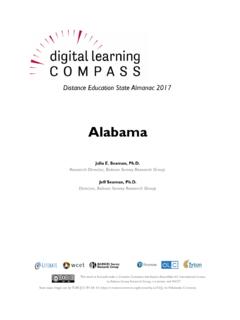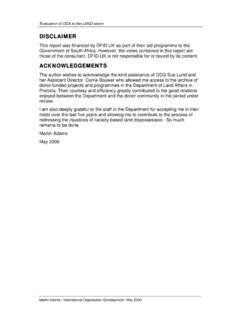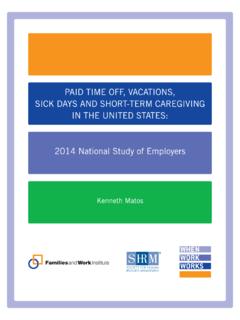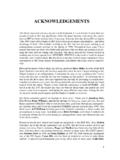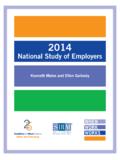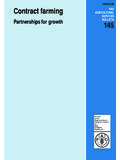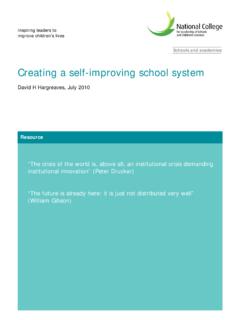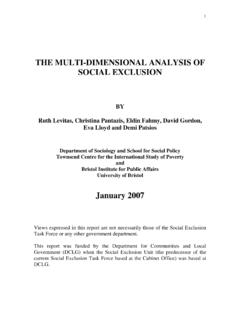Transcription of Grade Change - Babson Survey Research Group
1 Grade Change Tracking Online Education in the United States I. Elaine Allen, Professor of Biostatistics & Epidemiology, UCSF Co-Director, Babson Survey Research Group Jeff Seaman, Co-Director, Babson Survey Research Group January 2014 Cover design by Mark Favazza ( ). Copyright 2014 by Babson Survey Research Group and Quahog Research Group , LLC. Permission is hereby granted for all non-commercial use of this report provided that notification is given to and proper attribution is included. Commercial use may also be granted inquire at CONTENTS acknowledgements .. 1 Partners .. 2 Executive Summary .. 3 What is Online Learning, What is a MOOC? .. 6 Online Learning Is Online Learning Strategic? .. 8 Are Learning Outcomes in Online Comparable to Face-to-Face?
2 10 Schools Without Online Offerings .. 13 How Many Students are Learning Online? .. 15 Do Students Require More Discipline to Complete Online Courses? .. 17 Is Retention of Students Harder in Online Courses? .. 18 What is the Future of Online Learning? .. 20 Massive Open Online Courses (MOOCs) Who Offers MOOCs? .. 23 Objectives for MOOCs .. 25 Role of MOOCs .. 27 Survey Methodology .. 29 Tables .. 30 Babson Survey Research Group .. 40 1 acknowledgements Grade Change - Tracking Online Education in the United States is the eleventh annual report in this series on tracking online education in the United States. It was originally known as the Sloan Online Survey , in recognition of our founding sponsor, the Alfred P. Sloan Foundation. The Foundation saw the need for the first of these reports and continued that commitment, supporting this independent study, offering full privacy for all respondents as well as free distribution of all report publications.
3 We thank them for this. We also thank our current partners, the Sloan Consortium and Pearson, for supporting our Research with the same degree of independence and autonomy. Beginning in 2006, the College Board agreed to include our online enrollment questions as part of their Annual Survey of Colleges, providing increased coverage of all of US higher education institutions. We thank them for seeing the value in our reports, and being such a pleasure to work with. The report was edited and reviewed by Nate Ralph and we thank him for his suggestions, corrections, and careful attention to detail and consistency. As always, we would also like to thank the people most important to these Survey reports: the thousands of respondents who took the time to provide us with such detailed and thoughtful responses. We understand you are very busy people, and appreciate your effort.
4 These reports would not be possible without you, and we hope you find them useful. Co-Directors Babson Survey Research Group January 2014 2 PARTNERS Pearson Pearson has brought a wide array of experience in higher education to this project and will be producing the e-book version of the report and an infographic highlighting the results. Pearson, the world's leading learning company, has global reach and market-leading businesses in education, business information and consumer publishing (NYSE: PSO). Pearson helps people and institutions break through to improved outcomes by providing innovative print and digital education materials, including personalized learning products such as MyLab and Mastering, education services including custom publishing, content-independent platforms including the EQUELLA digital repository, and the Pearson LearningStudio online learning platform and OpenClass online learning environment.
5 The Sloan Consortium The Sloan Consortium (Sloan-C) has been a long-time supporter and distributor of the national online learning reports in this series for the past ten years. The Sloan Consortium is an institutional and professional leadership organization dedicated to integrating online education into the mainstream of higher education, helping institutions and individual educators improve the quality, scale, and breadth of education. Originally funded by the Alfred P. Sloan Foundation, Sloan-C is now a non-profit, member sustained organization. Alfred P. Sloan Foundation The Alfred P. Sloan Foundation is the founding sponsor of this report series. The authors wish to thank the Foundation for its support for the first eight years of this project. The Alfred P. Sloan Foundation is a philanthropic, not-for-profit grantmaking institution based in New York City.
6 Established in 1934 by Alfred Pritchard Sloan Jr., then-President and Chief Executive Officer of General Motors, the Foundation makes grants in support of original Research and education in science, technology, engineering, mathematics and economics. From 1992 to 2008, the Foundation s now completed Anytime Anyplace Learning program funded initiatives to develop, expand, and promote high quality learning online. THE STUDY DESIGN, Survey ADMINISTRATION, ANALYSIS AND REPORT PRODUCTION FOR THIS SERIES OF ONLINE LEARNING Survey REPORTS ARE THE SOLE RESPONSIBILITY OF THE Babson Survey Research Group . NO INDIVIDUAL-LEVEL DATA IS SHARED WITH PARTNER ORGANIZATIONS. 3 EXECUTIVE SUMMARY Grade Change - Tracking Online Education in the United State is the eleventh annual report on the state of online learning in higher education. The Survey is designed, administered and analyzed by the Babson Survey Research Group , with data collection conducted in partnership with the College Board.
7 Using responses from more than 2,800 colleges and universities, this study is aimed at answering fundamental questions about the nature and extent of online education. Is Online Learning Strategic? Background: Previous reports in this series noted the proportion of institutions that believe that online education is a critical component of their long-term strategy has shown small but steady increases for a decade. The evidence: When this report series began in 2002, less than one-half of all higher education institutions reported online education was critical to their long-term strategy. Last year that number was at an all-time high of close to seventy percent. The proportion of chief academic leaders that say online learning is critical to their long-term strategy dropped to 66 percent in 2013. Institutions that do not have any online offerings account for all of the decrease from 2012 to 2013, while those with online offerings are as positive in 2013 as they were in 2012.
8 The proportion of institutions reporting online education is not critical to their long-term strategy has dropped to a new low of percent. 4 Are Learning Outcomes in Online Comparable to Face-to-Face? Background: The reports in this series have consistently found a growing majority of chief academic officers rate the learning outcomes for online education as good as or better than those for face-to-face instruction. The evidence: The 2013 results show a small decrease in the percentage of academic leaders who view the learning outcomes for online instruction as the same of better than face-to-face instruction. The percent of academic leaders rating the learning outcomes in online education as the same or superior to those in face-to-face instruction had grown from 57 in 2003 to 77 percent in 2012. The upward trend was reversed this year, with a dip to 74 percent.
9 The proportion of academic leaders who believe the learning outcomes for online education are inferior to those of face-to-face instruction increased from 23 percent last year to 26 percent this year. Academic leaders at institutions with online offerings remain positive about the relative learning outcomes for online courses; all of the decrease can be attributed to leaders at institutions without online offerings becoming more negative. How Many Students are Learning Online? Background: For every year of this report series online enrollments have increased at rates far in excess of those of overall higher education at what point will we see online enrollment begin to plateau? Growth rates for online enrollments have been decreasing over the past few years will this trend continue? The evidence: The number of additional students taking at least one online course continued to grow at a rate far in excess of overall enrollments, but the rate was the lowest in a decade.
10 The number of students taking at least one online course increased by over 411,000 to a new total of million. The online enrollment growth rate of percent is the lowest recorded in this report series. The proportion of higher education students taking at least one online course is at an all-time high of percent. 5 What is the Future of Online Learning? Background: Academic leaders are well aware of the continued growth in online education. They also see what changes, if any, this growth has had for their own institutions. What do they think the future holds? The evidence: Chief academic officers are strong believers that the number of students taking online courses will continue to grow. They are divided on other aspects of the future of online learning. Ninety percent of academic leaders believe that it is Likely or Very Likely that a majority of all higher education students will be taking at least one online course in five years time.
